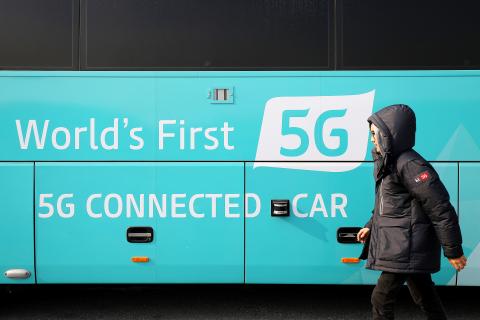Many countries are now preparing for the era of fifth-generation mobile communications technology (5G). In addition to the US, Asian countries including Japan, South Korea, China and Taiwan are all actively investing funds to deploy 5G infrastructure in a race to get the new network operational by 2020. At present, India — which generally lags behind in technology — also plans to provide a 5G telecommunications service within the next 4 years.
Looking back over the previous decade, one can trace the evolution of mobile communications from 2G GSM (voice and messaging) to the 3G era, when smart phones gradually became more popular, before slowly becoming a part of our everyday lives. Smart phones began to be used for everything from social networking apps to playing games. Mobile phone providers responded by offering “all-you-can-eat” promotional plans and smart phones became indispensable devices for connecting to the Internet.
With the advent of 4G, faster data transfer rates allowed users to experience a high speed network for the first time and use their phones to watch multimedia at a much higher quality than was possible under 3G. Watching live streams of sports matches, TV dramas or Internet celebrities have gradually become a part of modern life.

Photo: Bloomberg
照片:彭博社
Looking to the future, around the world 5G networks are projected to start becoming operational from next year onwards. Compared to 3G and 4G, which were aimed at meeting the needs of “people,” 5G is targeting the needs of “things.” 5G is expected to provide the speed boost required to realize the Internet of Things, create an entire set of new business opportunities and even transform industries.
5G will bring fast data transmission speeds and low latency with speeds 100 times faster than 4G and latency one-tenth that of 4G. Artificial intelligence technologies combined with 5G will further increase the capabilities of edge computing and will even allow on-device machine learning.
Although Taiwan’s mobile telecommunications industry is not involved in setting international standards, Taiwan is an important center for the global development of semiconductors and data communications components. From chip design and production to circuit modules and small cells, Taiwan possesses complete production chains. When the future new standards are released, Taiwanese supply chains will stand to benefit from the new market opportunities, which will help to propel forward industry growth in related fields. Most important of all, 5G will enable us to realize many of the possibilities and imaginations of the future, as well as create new applications for things that we have not yet dreamt of.
(Liberty Times, translated by Edward Jones)
各國積極備戰第五代行動通訊技術(5G)時代來臨,除了美國,日韓中及台灣等亞洲國家,也皆已積極投入資源佈署5G基礎建設,並力拚於二○二○年時進入商轉。目前相對處於技術後段班的印度,也計劃在未來四年內推出5G電信服務。
回顧過去十年,演進軌跡從2G GSM(語音、訊息)到3G時代智慧型手機逐漸普及,智慧型手機逐漸走入你我生活,社交軟體、手機遊戲等逐漸普及,搭配電信業者推出吃到飽優惠,手機連網變得不可或缺。
進入4G時代後,受惠於資料傳輸率的增加,讓使用者享受高速行動網路新體驗,手機上觀看影音品質相較於3G大幅提升,因此透過手機觀看實況球賽轉播、連續劇或是網紅直播,都已逐漸變成現代人的生活。
展望未來,全球5G預計二○一九年陸續進入商轉,相較於3G/4G針對「人」的需求,5G瞄準的則是針對「物」的需求,預期5G將加速物聯網的實現,同時帶動全新的商業機會,甚至推動產業變革。
5G具備高速傳輸,以及低延遲特性,傳輸速度是4G的一百倍,延遲則是4G的十分之一。人工智慧技術搭配上5G後,將可進一步提升邊緣運算的能力,甚至將使裝置具備機器學習的能力。
以台灣在行動通訊產業的角色來看,儘管並非國際標準的制定者,但台灣是全球半導體及資通訊零組件發展重鎮,從晶片設計、製造、模組終端、small cell等,都有完整產業鏈的國家,在未來新規格問世之後,相關供應鏈將受惠市場商機的崛起,帶動相關產業成長機會。更重要的是,5G開啟更多對於未來的想像與可能,那些「還沒想像到」的應用,可能形塑我們未來的生活。
(自由時報記者廖哲宏)
Follow Up
讀後練習
The Internet of Things (IoT) is a network of connected devices with embedded sensors and connectivity that allow connection to a network to share data. These “things” are not standard devices such as smartphones, laptops and tablets, but “dumb” devices and appliances that are not traditionally Internet-enabled, such as toasters, fridges, washing machines, burglar alarms and smoke detectors. According to the latest research, it is estimated that there will be 30 billion IoT devices by 2020, by which time the global IoT industry is expected to be worth US$7.1 trillion.
The projected explosion in the number of devices connected to the Internet has attracted security concerns. There is the potential for built-in cameras and microphones to be turned on remotely, electronic door locks to be compromised and burglar alarm systems to be switched off remotely. Furthermore, IoT devices could be used as a “back door” into a home or business’ computer network and allow hackers access to sensitive or personal information.
According to Mikko Hypponen, chief research officer at Finland-based IT security company F-Secure, a smart device means an exploitable device, and hackers are looking for ways to make money out of the IoT. For companies that produce IoT devices, security will never be the main design goal, Hypponen says.
(Edward Jones, Taipei Times)

In an effort to fight phone scams, British mobile phone company O2 has introduced Daisy, an AI designed to engage phone con artists in time-wasting conversations. Daisy is portrayed as a kindly British granny, exploiting scammers’ tendency to target the elderly. Her voice, based on a real grandmother’s for authenticity, adds to her credibility in the role. “O2” has distributed several dedicated phone numbers online to direct scammers to Daisy instead of actual customers. When Daisy receives a call, she translates the scammers’ spoken words into text and then responds to them accordingly through a text-to-speech system. Remarkably, Daisy

Bilingual Story is a fictionalized account. 雙語故事部分內容純屬虛構。 Emma had reviewed 41 resumes that morning. While the ATS screened out 288 unqualified, she screened for AI slop. She could spot it a mile away. She muttered AI buzzwords like curses under her breath. “Team player.” “Results-driven.” “Stakeholder alignment.” “Leveraging core competencies.” Each resume reeked of AI modeling: a cemetery of cliches, tombstones of personality. AI wasn’t just changing hiring. It was draining the humanity from it. Then she found it: a plain PDF cover letter. No template. No design flourishes. The first line read: “I once tried to automate my

Every May 1, Hawaii comes alive with Lei Day, a festival celebrating the rich culture and spirit of the islands. Initiated in 1927 by the poet Don Blanding, Lei Day began as a tribute to the Hawaiian custom of making and wearing leis. The idea was quickly adopted and officially recognized as a holiday in 1929, and leis have since become a symbol of local pride and cultural preservation. In Hawaiian culture, leis are more than decorative garlands made from flowers, shells or feathers. For Hawaiians, giving a lei is as natural as saying “aloha.” It shows love and

1. 他走出門,左右看一下,就過了馬路。 ˇ He walked outside, looked left and right, and crossed the road. χ He walked outside and looked left and right, crossed the road. 註︰並列連接詞 and 在這句中連接三個述語。一般的結構是 x, y, and z。x and y and z 是加強語氣的結構,x and y, z 則不可以。 2. 他們知道自己的弱點以及如何趕上其他競爭者。 ˇ They saw where their weak points lay and how they could catch up with the other competitors. χ They saw where their weak points lay and how to catch up with the other competitors. 註:and 一般連接同等成分,結構相等的單詞、片語或子句。誤句中 and 的前面是子句,後面是不定詞片語,不能用 and 連接,必須把不定詞片語改為子句,and 前後的結構才相等。 3. 她坐上計程車,直接到機場。 ˇ She took a cab, which took her straight to the airport. ˇ She took a cab and it took her straight